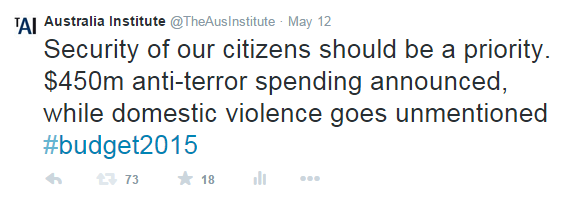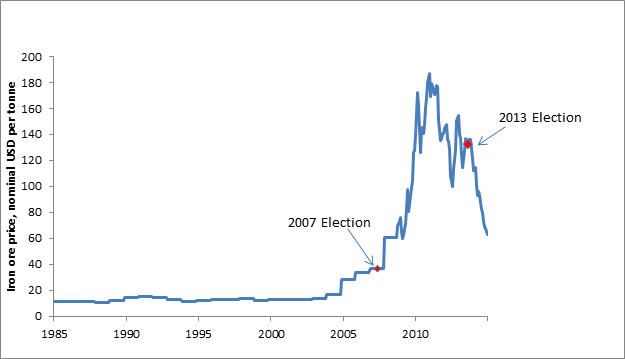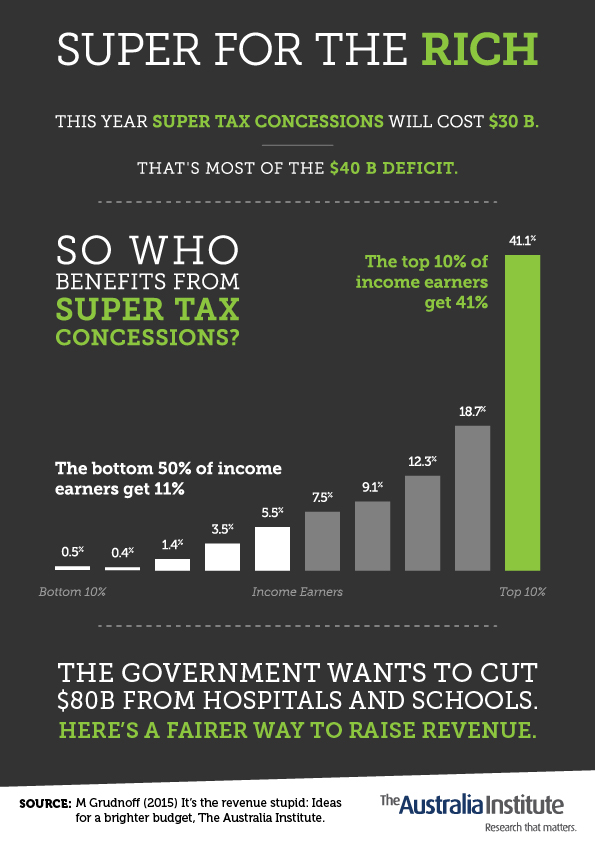Budget 2015: TAI’s Verdict
Joe Hockey’s second budget was much better armoured than his first. The brazen nature of the first budget made the task of those critiquing it pretty easy. This one took more time and detailed analysis to break down.
Our verdict: The 2015 Federal Budget doesn’t fit the 2015 Australian economy. It ignores obvious and major issues, and attempts to solve problems that don’t exist. Creating a political document is easy, and by doing so Abbott and Hockey have missed opportunities and this will harm the economy, environment and people of Australia for many years to come. In a word, the Budget is ‘lazy’.
Last week, we described Joe Hockey’s pre-budget message as ‘more than mixed, it’s pureed’. And this Budget proved to be a mish-mash of measures, with no coherent economic strategy.

Thank you for the many responses to our offer to join us in the lockup; they helped guide our work as we poured through the Budget Papers. We have addressed some of the most frequently raised issues below. Some items remained unchanged from last year to this, keeping the issues out of the news, but we note that in a lot of cases that means cementing the cuts of last year’s horror-budget.
- The Lazy Budget
- One Handout Washes the Other
- Joe Jilts Austerity and Stumbles on Stimulus
- Everything’s Bigger in Taxes
- Unpacking the Small Business Package
- TAI Budget Media
—Click here to get fortnightly updates on what Richard Denniss and The Australia Institute have been up to.–
The Lazy Budget
Rubbery figures
It seems every budget over the last few years has claimed that there will be decreasing budget deficits in the out years. This budget is no different. While there is no surplus claimed in any of the years the government does claim that by 2018-19 the budget deficit will fall to $7 billion.
It is important to remember that this time last year the government was claiming this year’s budget deficit would be $17.1 billion. On Tuesday they said $35.1 billion. If the budget deficit can double in just one year imagine how much it can change in four years.
The current guess for this year’s budget deficit is based on a bunch of savings that have been rejected by the senate. We found $2 billion worth that the senate have vowed to block. If they do then this year’s deficit will increase by $2 billion to $37.1 billion.
It is important to remember that all these figures are rubbery. Nothing highlights this more than the government announcement that $90 billion in revenue has been written off the forward estimates. If Treasury can lose $90 billion dollars what chance does a $7 billion deficit in four years’ time have?
Iron Ore Poor
In the 20 years from 1985 to 2005 iron ore averaged $13.17USD per tonne. The revenue streams in Joe Hockey’s budget into the future are based on a price of iron ore of $48USD per tonne. This might be true, and there’s an argument that given Australia’s dominance of the world market, we could even have some say in that. However, it does go to show the dangers of spending billions of taxpayer funds to assist mining companies, rather than investing in say health, innovation and education.
Iron ore prices: What goes up…

One handout washes the other
When is a handout not a handout?
The Treasurer has a unique spin on what a hand out actually is. When Leigh Sales on 7.30 described the budget as giving handouts, the Treasurer angrily responded that $20,000 in instant tax write offs was not a hand out because the government was simply giving people back their own money.
This is ideological spin pure and simple. There is no difference between a government giving someone $100 in cash and giving them an extra $100 on their tax refund. The Treasurer is inventing the distinction so he can imply that people who get government largess by paying less tax are more virtuous than those that rely on government payments.
If the Treasurer’s distinction is actually true then why was he claiming a crackdown on tax minimising multinationals? Surely they are just claiming back their own money.
While this budget had less crass us-and-them analogies like the ‘lifters and leaners’ of the last budget, it is clear that the Treasurer has not learnt very much. He seems to think tax loopholes are good and virtuous and those that rely on government payments are not. What a coincidence that it is mainly high income earners who take advantage of tax loopholes and low income earners who rely on government payments.
Joe Jilts Austerity and Stumbles on Stimulus
The absence of action can be as powerful as any act, particularly in changing times. Economic debate since the GFC has often been put in terms of Austerity vs Stimulus. Joe Hockey, on the surface, appears to have done neither. However, analysis by TAI senior economist, Matt Grudnoff, has found that the dabbling done in these areas will leave nasty legacies.
Austerity – The Budget’s bad houseguest lingers
The budget has downgraded growth forecasts again. The economy is expected to grow by only 2.75% next year down from 3% which was estimated just 6 months ago. Unemployment is now expected to increase to 6.5% next year up an estimated 6% just 6 months ago. The Reserve Bank just lowered interest rates to record lows. All this points to a weaker economy and it requires a strong government response.
What we got in the budget was an optimistic Treasurer who is not very keen to do anything and a nothing budget. In fact this budget has changed significantly from last year’s budget. But rather than heading in the right direction we have lurched from one bad budget to another.
In opposition and then up until very recently the government had been running a very strong argument for austerity. We were constantly being told that we can’t live beyond our means. We had a budget emergency and the biggest crisis facing Australia today was the debt and deficit disaster.
This has completely vanished in this year’s budget. Some of the old rhetoric is still being pulled out but this is not a budget from a government that is concerned about the size of the deficit.
Stimulation, Joe’s new to it
In the budget papers we even see small signs of what might be stimulus. But given its size it could just as easily be mistaken for electoral pork barrelling. The small business package that allows purchases of up to $20,000 to be written off against tax seems to be aimed to encourage spending to stimulate growth and employment.
Of course stimulation only works if you’re adding extra money into the economy. If you put $2 billion in one program but then take out $2 billion in another program the net effect is likely to be zero. The Treasurer has been proudly telling everyone who will listen that all his new spending measures are being offset by savings measurers. Not a particularly smart move if you’re trying to stimulate the economy (as the Reserve Bank is doing).
A close reading of the budget papers reveal that the Treasurer is not actually correct. New spending measures are expected to increase by $10 billion over the next four years. This is partly offset by $2 billion extra revenue in new revenue measures. This means that we have an addition of $8 billion over four years being injected into the economy or an average of $2 billion per year.
$2 billion in an economy of $1,560 billion is hardly likely to have much effect.
Everything’s bigger in Taxes
Can you feel your bracket creeping?
At the release of the Intergenerational Report earlier this year the Treasurer told us that one of his biggest concerns was bracket creep. He claimed that it was unacceptable that someone on average earnings would be in the second highest tax bracket.
So what has the Treasurer done about it? Well…nothing.
In fact bracket creep is what the Treasurer is hoping will bring his budget back to surplus. This is the laziest tax policy. Bracket creep disproportionality impacts on low income households.
This is a massive missed opportunity. Instead of taxing smarter the government is being lazy. We could have wound back negative gearing and abolished the capital gains tax discount. This could raise $7.4 billion a year, help reduce speculation in the property market and make it more affordable to buy or rent a home.
The government could tackle rapidly growing super tax concessions. It could repurpose super tax concessions so that they do what they were designed to do, reduce pressure on the age pension. This could raise $10 billion or more.
This money could then be used to offset bracket creep. This budget has completely ignored tax reform.
$30 billion+ of savings, ignored:

They raised the GST and no one cared or noticed
Over the years the GST has been the most divisive of tax debates. What a surprise then to find the coalition break a promise not to change the GST and have virtually no comment on it at all.
In the budget, the government extended the GST to include imported digital products. It is expected to raise $350 million over two years.
With such a muted reaction to small changes in the scope of the GST maybe the government should consider extending it to private schools and private health insurance. A TAI paper found that this could raise $2.3 billion, a third of which would come from the highest income households.
That small business package
The government has put together a package of goodies for small business but to distract from it looking like a political ‘handout’ they have attempted to sell it as a jobs package.
The main items assisting small business are:
- Tax cuts for businesses with turnovers up to two million dollars which involve:
– cutting the company tax rate from 30 to 28.5 per cent and
– a five per cent discount in tax paid by unincorporated small business up to a maximum of $1,000 pa.
- Accelerated depreciation so that items worth up to $20,000 can be immediately deducted rather than written off over time.
These two measures cost $3.3 billion and $1.8 billion over the next four years. In addition there are some very minor concessions for exemption from capital gains tax for changes to an entity’s structure, immediate deduction for professional expenses involved in setting up a business, and changes to small business fringe benefits tax arrangements for mobile phones and the like.
Tax cuts for business are unlikely to have much impact on their employment and growth plans.[1] Giving small business more money does not increase demand for their product. They will only employ more people when they need to sell more stuff.
The accelerated depreciation measures may encourage further spending on office furniture, machinery and office equipment. This may well generate some new spending but it is more likely to just bring forward planned spending on the part of small business. It is also likely to appeal to all those tax avoiders who seek to disguise private spending as tax-assisted business expenses. In any event it is not sufficient to prevent unemployment increasing from 6.25 to 6.5 per cent between the June 2015 and June 2016 quarters as shown early in Budget Paper no 1.
So if the government’s handout to small business is not likely to have much of an impact on jobs, is the government serious about growing employment? There are some relatively minor employment measures mainly with the Youth Employment strategy. But despite this, in budget paper no 1, table 16, there is only small increase in spending on ‘Labour market assistance to job seekers and industry’ and a very flat level of funding for ‘vocational and industry training’. Hardly the results you would expect for a government trying to reduce unemployment.
The government has been forced to abandon its policy of making people under 30 wait 6 months for unemployment benefits because the senate refused to pass it. This has not deterred them from punishing the victims of the sluggish economy. They have simply reduced it to those under 25 and reduced their wait time down to 4 weeks. While the government seems to think this is an employment strategy it is hard to see how forcing people into poverty will increase the number of jobs.
One of the most remarkable measures in the growing jobs and small business package is ‘further strengthening the job seeker compliance arrangements’ which will spend $24.9 million in the departments of Human Services and Employment on measures that will save $6.9 million in payments to those on unemployment benefits! Put simply they are hoping to crack down on those who receive unemployment benefits. Again it’s hard to see how this will grow the economy and create more jobs.
Putting some of these things together gives us a boost in after-tax incomes for people with business interests , nothing that improves the lot of the unemployed or their likelihood of finding work and a further attempt to use sticks to encourage them to look for the jobs that just are not there. This and other parts of the 2015 Budget will worsen the distribution of income in Australia.
[1] Richardson D (2014) ‘The taxation of capital in Australia: Should it be lower?’ In Schroeder SK and Chester L (Eds) Challenging the orthodoxy: Reflections on Frank Stilwell’s contribution to political economy, Springer, pp 181-202.
Weekly updates from TAI
We aim to keep you updated every week. Every fortnight we send out the Between The Lines which provides an overview of our research and topical issues. On alternate weeks we send out a newsletter based on our work in equity and mining. If you would like to receive those, click here, choose your newsletter, and we’ll make sure they land in your inbox.
Between the Lines Newsletter
The biggest stories and the best analysis from the team at the Australia Institute, delivered to your inbox every fortnight.
You might also like
Public Interest Sold Out for Private Profit | Between the Lines
The Wrap with Richard Denniss It’s not true that increasing government spending will make inflation worse. It’s also no accident that those opposed to small increases in unemployment benefits, arguing it will cause inflation and worsen the cost of living, have been strategically silent about the impact of spending $268-368 billion on the AUKUS submarines.
Bringing in the Budget | Between the Lines
The Wrap with Richard Denniss Budgets, like life, are all about priorities. It’s easy to talk about all the things we can do, but it’s harder to decide where we’re going to channel our efforts. And as in life, sometimes the hardest part of prioritising is telling other people that their priorities aren’t yours. On
Don’t worry about a budget surplus, care about the choices in the budget
Budget, Julia Gillard rightly said, are about choices. And those choices are a lot more important than whether or not the budget is in surplus or deficit


